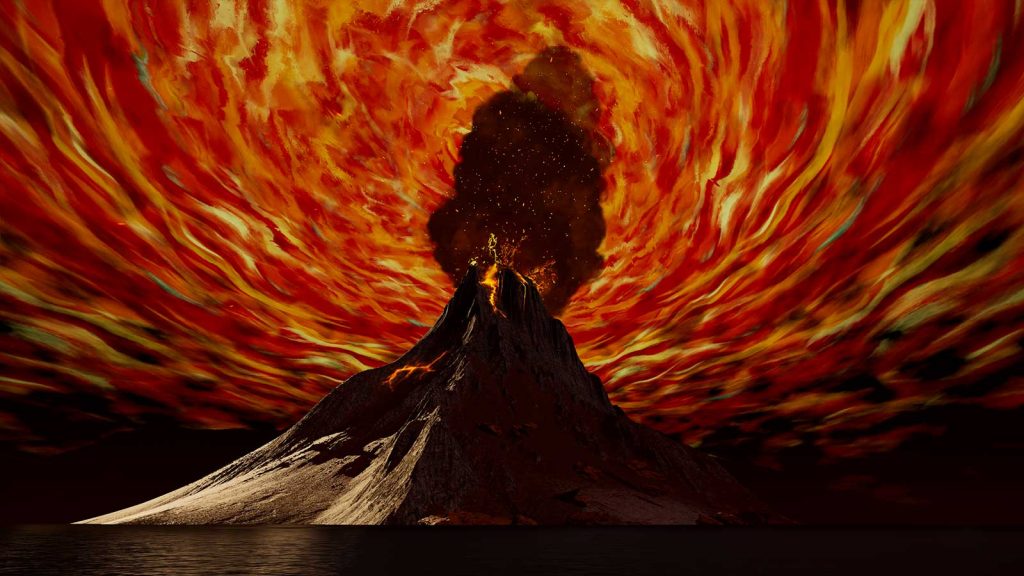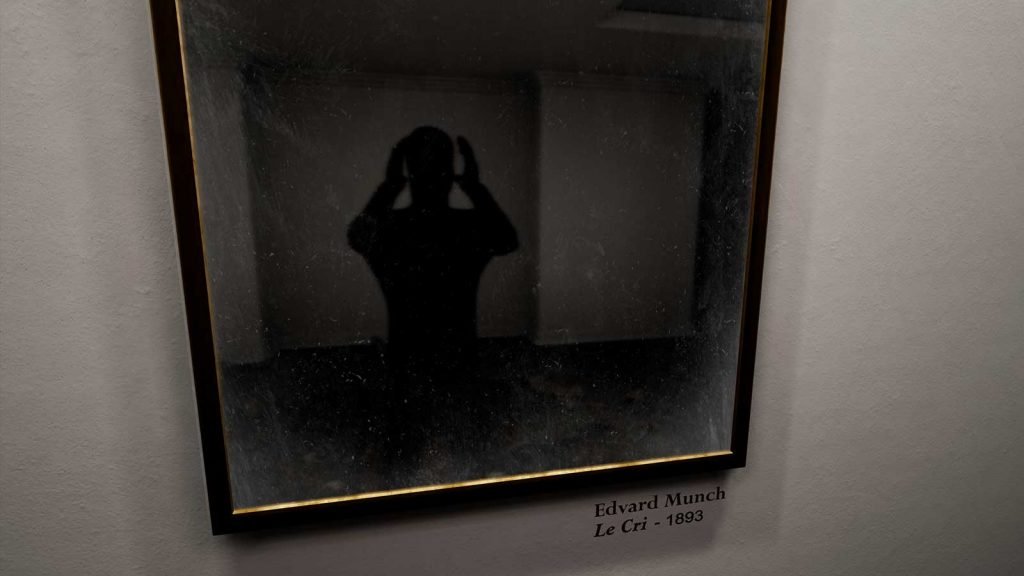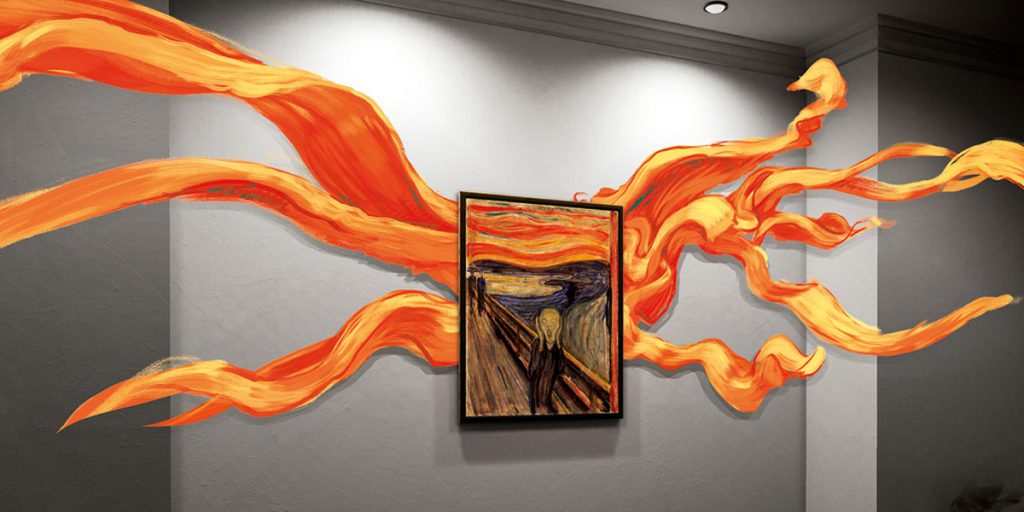Munch’s The Scream comes alive in immersive VR experience Le Cri. Our interview with directors Sandra Paugam and Charles Ayats!
Virtual Reality can take you to extraordinary places. It can transform you into a black hole and let you play with the planets’ orbs as you float in the middle of the universe, it can enable you to physically interact with imaginary characters and it can even bring those characters to life as you watch. This extraordinary medium has made room for a whole new kind of storytelling – one that has no limits of time and space and one that can move us, inspire us and educate us with immersive experiences and groundbreaking technology. Sandra Paugam and Charles Ayat’s Le Cri is one of those experiences.
Part documentary, part exhibition and part sensory experience, Le Cri (The Scream) is a virtual museum that takes you face to face with one of the most captivating (and disquieting) paintings in history, Edvard Munch’s The Scream. It’s an interactive experience that lets you touch the painting and witness it change as you learn about its history, and it’s a journey into the painter’s tortured mind that keeps taking new shapes. It will take you to the most unexpected places, until you find yourself having to face your own fears and demons. Because Le Cri is about exploring art and expressing emotions, but it’s also about experiencing all the anxiety from which it originated. It’s a new kind of VR experience, one that will take you on a journey of self-discovery you won’t forget.
We embarked on this fascinating journey at the 2019 Venice Film Festival, where we interviewed directors Sandra Paugam and Charles Ayats: here’s what they told us on their impressive “Virtual Museum”.

Le Cri: a Documentary Experience in Virtual Reality
How did this ambitious project take shape and what made you want to create an “interactive and sensory Virtual Reality experience” that was also a documentary and, in a way, a museum exhibition?
Charles: Le Cri VR is, in a way, the result of an investigation on Munch. Why did he paint The Scream? Our experience is an interpretation of his work, based on documentary researches. It’s a documentary experience, but that uses VR staging and interactive mechanics to intensify our intentions, that is to place the user in a virtual museum room. It is also true that one could perceive this experience as the future of audioguides… immersive, sensory, a content to experience rather than listen to.
Sandra: I am a documentary TV director, doing a lot of films on art. When I experienced VR for the first time, I thought it could be a great way to explore paintings. It was a very interesting challenge for me to find a way to give information with a new medium that could envelop the spectator and give him the opportunity to interact and not only be passive.
I thought it was also a good way to improve our relationship with paintings in museums. It’s almost impossible nowadays to have a quiet and direct relationship with a work of art, especially with masterpieces, because of the success of exhibitions and museums. It’s a good thing, but it’s difficult to have time, alone with a painting, even more when this painting is the Scream from Munch.
When did you know that Edvard Munch’s The Scream was going to be at the centre of your “VR exhibition” and why did you choose this specific painting?
Sandra: When we spoke about this project with the producer, David Bigiaoui, who really accompanied us in each step of the project, his first reflex was to choose a painting with a lot of details, , that would enable spectators to get into it and discover it in a very sensitive way. It’s a very good way, of course, to be included in a work of art. But I didn’t want to proceed like this, for different reasons. First, I thought that it was too “easy” to get into the painting with a VR experience. In a way, that’s what almost everybody attempts to do. Most of all, I have an immense respect for the artists who gave us their vision of the world in a very specific way, in this case two-dimensional, and I felt it would have been “treason” to paint in the manor of Munch, and attempt to reinvent the environment of his painting.
That’s why I very quickly chose the contrary, in a way: a work of art with few details, and which has a very direct impact on the spectator. For me, The Scream was an obvious choice because everybody knows it, and the painting is so strong: it’s as if it jumps out at you. Nobody can stay indifferent in front of it. Something also very important in this painting is the “hors-champs”, “off frame”. You don’t know what the figure sees or hears. And you don’t even know if he is screaming, and, if yes, the reason why.

This painting is iconic and, as all icons, it has been used in very popular ways: the mask of the movie “Scream” is directly inspired from the face of the Munch’s figure. And the emoticon for horror and anxiety comes also directly from the painting. So what I wanted to do is to find a way to feel this anxiety in the experience. I thought that we could play with the “off frame” without having to recreate the décor of the painting, and that we could play more with feelings. And it was also a chance to spend time with it.
Charles: There is another trick. For me, paintings are projections, as a movie resumed in one image. Expressionist’s’ goal is to transmit feelings between viewers and their art. VR is the perfect medium to express emotions. VR is embodiment. In real time. All artists, children of expressionism movement, should create VR experiences.
How Le Cri approaches anxiety
Le Cri is a fascinating look into Munch’s mind, but it’s also an unsettling experience that puts us face to face with our anxieties from beginning to end. How did you manage to approach the subject of anxiety and trigger all these emotions so effectively?
Charles: It’s not us, it’s the painting: everything is inside!
Sandra: One of the richest feelings I had with a work of art was when I spent time in Bill Viola’s installation called “The Sleep of Reason”. I stood in an almost empty room: the only object was a sideboard with a TV on, where I could see and hear a man sleeping. Suddenly, some video images were projected on one of the walls, for a very short time, causing a big surprise. This process repeats itself, and you have no way of knowing on which wall of the room and for how long the video images will appear. I experienced a strange feeling, close to anxiety, because of the surprise and also because of the difference between the very quiet room and the powerful violence of the images and sounds that accompany them.
But, at first, I thought that the VR experience should be passive for the user, as in Bill Viola’s installation where the visitor suffers through the images. That’s where Charles’s experience was very helpful: he was able to suggest interactivity, which is a strength of VR. We quickly found the form, a three-chapters experience with one theme that could find its roots in Edvard Munch’s life, but that could also be connected with todays’ interrogations.
The painting changes in more than one way throughout the installation, so much that, at times, it stops being a painting altogether. How did you think of incorporating the idea of the mirror?
Sandra: The experience is built with concentric circles: first, you are confronted with nature, which seems to be something from the “outside”. Then death, which causes “inside” reactions, then the society that concerns everyone, every day. I thought it would be normal to finish with ourselves.
I always thought that, if at the end of The Scream VR you could understand that you’re still concerned, and that maybe you could become the figure of anxiety that is the Scream, the experience would be a success. So the mirror was the best way to express it.
Charles: Yes, it is a way to remind the player that what he can see inside the frame is the work and the expression of another human being. That he could do the same: be moved intellectually, project his fears, his thoughts, and paint the reflection of his soul.

An ever-changing, interactive VR exhibition
When the “exhibition” begins, we are sitting on a bench, looking at a painting. By the time it’s over, not only have we become extremely familiar with both, but we have seen them change and evolve in many ways, and, most of the time, we participated actively in these changes. The level of freedom that is given to the viewer in Le Cri is truly impressive, and it’s part of what makes it so great.
What were the main challenges of creating a VR experience that allows its users to interact with it so freely and independently?
Charles: It is really complex to be “efficient” when designing a VR experience. The viewer or player is free or, at least, he should believe he is. It takes a lot of iterations on timers and triggers to create a coherent, successful succession of steps without giving the feeling of a scripted experience.
Add this to the fact that, when you see your hands in VR, you lose 50% of your attention. It creates the desire and need to touch everything around you, so you can understand what is this shared reality. Our main challenge was maybe to create a balance between voiceover information and environmental storytelling.
Sandra: We had many, many discussions about what we should let the viewer do. It was clear for all of us since the beginning that the experience would take place in a museum room. It was an opportunity to begin in a very classical way, and then to cause surprise. We had a lot of discussions about the voice that gives you information: we wanted it to be very realistic and almost boring, just like an audioguide is. Should it evolve as you go into the experience? Or should it stay the same? We collaborated for all the sound aspects with Franck Weber who was very helpful in creating interactive sounds. We chose not to alter the voice and to add some music and specific sounds when the painting gets transformed.
For a while, we had the idea to leave the viewer completely free and to not help him with sounds or with visual triggers. We did some tests, and saw that a lot of people didn’t move from the bench. So we decided to accompany each interaction both visually and with sound. We worked with Backlight’s team, who developed the project, to find the best way to make it happen in a subtle way. It was still important for us to give the viewer enough time to explore, to progress in the experience at his own pace. We didn’t want to give him all the solutions.
I think the biggest freedom you have is that we give you the opportunity to touch The Scream. At first, I thought that was out of the question. We had a lot of discussions inside the team. They all wanted to do it… I needed more time to understand that it was a great idea, because where else in a VR experience can you touch a work of art?

The Future of Le Cri
What’s next for Le Cri?
Sandra: Le Cri has been having a very beautiful life at festivals. It’s been part of Annecy Animation Festival’s first VR competition and part of the Best Of 2019 at Venice Film Festival. It’s already been shown at Anima Brussels, where it won the Audience Award, which I’m quite proud of!
Even if nothing can be as nice as having a direct contact with a painting, I’d love for Le Cri to be shown in museums. As soon as we began to work on it, we imagined an installation, in the museum-related sense of the term. Creating a sensory experience is also working on the relationship between the real and the virtual. That’s why we use Leap Motion in our installation. By interacting with his own hands, the viewer creates a contact between the real and the virtual.
For now, The Scream is available online, on Steam & VivePort, for 6 DoF headsets.
What’s next for you? Can you tell us about your future projects?
Sandra: For the moment, I have no VR project. I just directed two documentaries about artists for French TV. But I would be glad to reiterate the experience.
Charles: I just finished another VR project named “7 Lives”. My next project will be on AR, a whistleblower story in 2040!
Le Cri was shown at the Venice Film Festival as part of the Biennale’s “Best of 2019” Virtual Reality programme. You can experience it online on Steam and VivePort.

